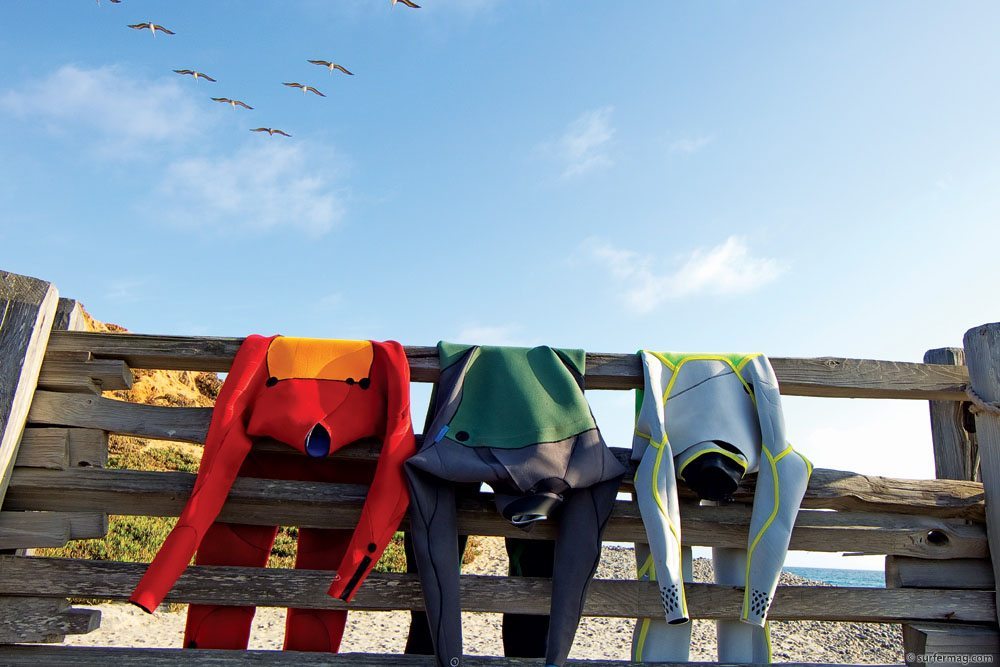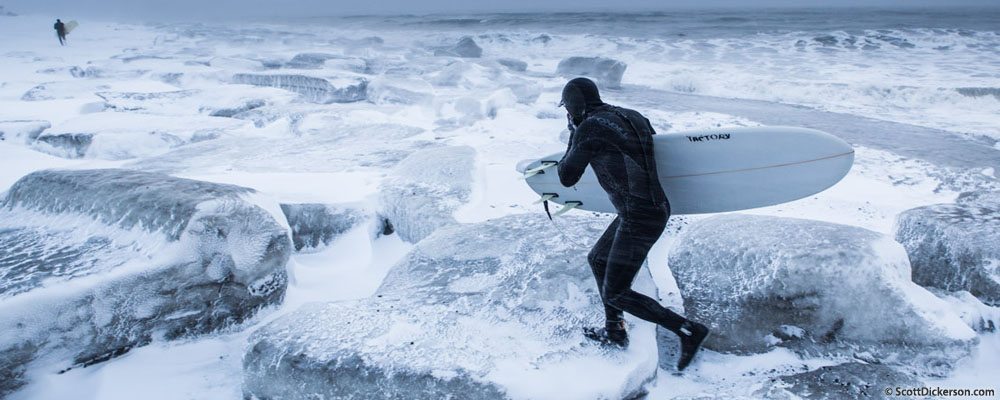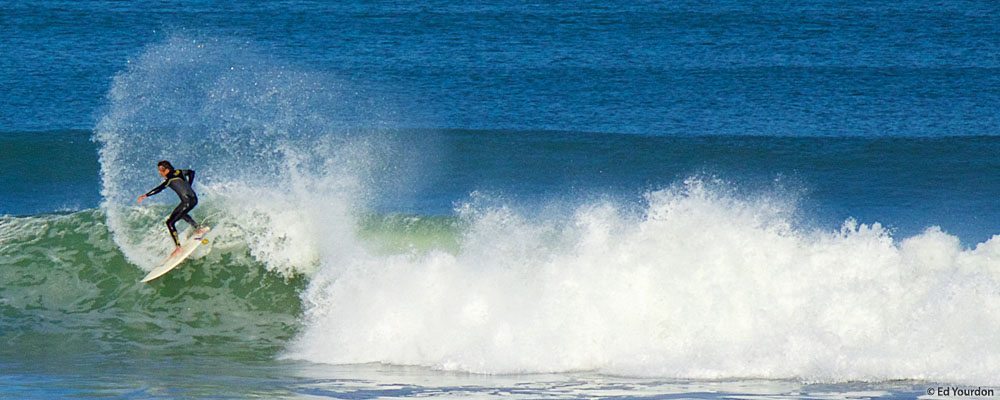
How To Choose The Right Wetsuit
Find out how to choose the perfect wetsuit, no matter where you live or your surfing ability. We’ll give you the lowdown on wetsuit jargon, the difference between high-end and budget wetsuits, how to get the best fit and how to take care of your wetsuit. All you need to do is dive in!
[su_box]
Why do I need a wetsuit?
In most of Europe you’ll need a wetsuit for at least three quarters of the year. In water temperatures that in France alone can range from 8 to 25 degrees, most enthusiastic surfers will have 2 or 3 wetsuits in their armoury. They’ll have a spring suit, a summer suit and winter wetsuit so they can surf comfortably all year.
What do the numbers that describe wetsuits actually mean?
The numbers 5/3, 4/3 and 3/2, etc, refer to the thickness of the neoprene in millimetres and therefore describe how warm the wetsuit is. A 5/3 wetsuit will be 5 mm thick on the trunk and 3 mm thick on the arms and legs. The same logic applies to 4/3 and 3/2 wetsuits that use thinner rubber and therefore aren’t as warm.
Your choice will depend on the season you plan to use your wetsuit, the water temperature, wind speed, but also how much you personally feel the cold. In 13 degree water like you’d find in winter on the French Atlantic coast, you would go for a 4/3. Once the water temperature reaches 16 degrees in spring, you could switch quite comfortably to a 3/2. For winter throughout most of the UK, you’ll need a 5/3.
Why is there such a big difference in price between seemingly similar wetsuits?
Contrary to what you might think, you’re not being ripped off, there’s a genuine difference in the materials used. The most expensive wetsuits use a more flexible neoprene which means you can move more easily and generate more heat.
Some progressive brands are moving away from petro-chemical neoprene and favouring instead limestone or Yulex neoprene. Developed by the Japanese company Yamamoto, the limestone neoprene is made from calcareous rock. These wetsuits are more expensive, but also a lot more environmentally friendly, lighter and more flexible.
Unlike surfboards, the best wetsuits aren’t only for the best surfers, rather it’s purely down to your budget.
Another factor affecting the price is the location of the zip. A wetsuit with a chest zip is generally more expensive than one with a back zip, but it’ll also be more supple, less irritating and better at keeping the water out.
[/su_box]
Winter Wetsuits and Steamers
Extra Cold Water Wetsuits – below 10 degrees
5/3 – UK, Ireland, East Coast USA
There’s only one way to brave the winter waves in northern Europe and that’s to invest in some serious rubber. Go for a thick steamer with at least 5 mm in the core and complete the look with booties, gloves and a hood.
The latest 5 mm wetsuits are a far cry from the stiff, scraping torture instruments of yesteryear. These days the neoprene is lighter and more flexible meaning it’s easier to get a great fit, which is the number one factor if you’re going to stay warm and enjoy your session. Some wetsuits also come with a thermal lining which adds warmth and comfort against the skin, and chest zips that minimise cold water flush and mean there’s greater flexibility across the back and shoulders for paddling. It’s all about maximizing your time in the water and making your sessions fun even in the harshest conditions.
Cold Water Wetsuits – 10-15 degrees
4/3 – France, Portugal, Northern California
If you’re planning a winter surfari, or if you happen to live in a European spot like the south of France, Portugal, Italy or Spain, you will need a 4/3 mm wetsuit with some booties, and maybe gloves and a hood.
The water temperature along the European coastline can be unpredictable and the weather changeable, so in an ideal world you’d have a couple of different wetsuits to choose from. However, if you can only pack one suit this winter, choose a 4/3.
Again, focus on getting a great fit as that’s the number one factor that will influence comfort and warmth. Some top end wetsuits like the Xcel Drylock range have fully sealed seams and an inner lining that serves to recycle body heat.
3/2 Spring Wetsuits
Cool Water Wetsuits – 16-19 degrees
3/2 – European Spring
In April or May in the northern hemisphere, you can ditch that heavy steamer and break out the 3/2 spring suit. When choosing a spring suit, think about how often you’re going to surf. Do you need a quick drying flash lining because you want to surf twice a day? Or super flexible neoprene to throw down aerial moves? Or just a simple warm and comfortable wetsuit to catch your first waves?
2/2 Summer Wetsuits
Warm Water Wetsuits – above 20 degrees
2/2 – Canary Islands
Battle the lineup and catch those summer waves with the freedom of a summer wetsuit.
There are loads of options for warm summer water. Choose from trendy retro long-johns, short sleeves and long legs, short sleeves and short legs, or even 2mm full suits. In the height of summer you may want to break out your rash vest, 1 mm neoprene top, technical board shorts or bikini.
The summer tourists may have arrived, the waves may be smaller and busier, but at least you can surf free without that thick layer of rubber.
Wetsuit Thickness
The thickness of a wetsuit is measured in millimetres, represented by two numbers for example 4/3 or 3/2, etc. The first number represents the thickness of the Neoprene around the torso area and the second number refers to the extremities. It’s your core that needs to stay the warmest and your arms and legs need the flexibility to move.
Modern wetsuit technology means that you can pretty much drop a mm compared to a few years ago. The neoprene is more flexible, which helps generate warmth and on some higher end suits it’s laced with materials that help reflect body heat back in, or super warm and quick drying fleece linings (more below).
Wetsuit Neoprene
A wetsuit is a neoprene insulation suit made for warmth and protection in watersports. Neoprene is made of small closed cells that are filled with air which provide insulation against cold water by trapping heat in. It works by trapping a thin layer of water between your skin and the wetsuit. Your body heats up this water and keeps you warm. The thicker the neoprene, the warmer the suit will be.
Discovered in the 1930’s by the Du Pont company, this foam-feel Neoprene is spongy, stretchy and waterproof, offering better insulation and durability than natural rubber.
Neoprene first revolutionised surfing in the 1950’s allowing surfers to spend more time in the water than ever before.
Later, the addition of Nylon, thermal layers and outer membranes improved durability, warmth and allowed a much better fit. This allowed surfers to explore spots in much colder conditions.
Neoprene from different brands and a different price points will offer different levels of flexibility, stretch and warmth.
Wetsuit Lining
Longer surf sessions and even more comfortable wetsuits are possible by adding a thermal lining to the inner construction of the suit. These are sometimes referred to as firewall or bio-fleece layers depending on the brand.
Thermal linings are available on mid to high end wetsuits and are usually located on the front and back panels of the torso section. Thermal linings give you the warmth of a classic 4/3mm whilst only wearing a 3/2mm – meaning more flexibility and less weight. Moreover, these thermal linings are not only more comfortable than classic Neoprene, but they also dry faster, so you can use the same wetsuit twice in one day. Getting a wetsuit with one of these liners has to be considered if you intend on surfing in cold waters or you are sensitive to the cold.
Wetsuit Stitching
There are different types of stitching used in wetsuit construction depending on the brand, performance and price. Classic stitching techniques can sometimes involve making holes in Neoprene and passing a thread through. These holes can let water though the waterproof Neoprene barrier, so the type of stitching is important when considering how warm a wetsuit will be.
New construction styles, materials, tape, glue and stitch-less technology will keep you warmer and more flexible than ever.
Flat Lock Stitching
Flatlock stitching involves laying one panel edge over the other, then stitching though the Neoprene. The interior and exterior seams look about the same
GBS (Glued and Blind-stitched)
The edges of the panels are placed end on end and glued together, then stitched on the inside but the stitching does not go all the way. GBS can have inside tape to improve strength and longevity, also reducing water entry. The interior and exterior seams don’t look the same.
Sealed and Taped
This means seams are glued and blindstitched with and additional flexible liquid tape is fixed to the exterior, with extra tape to reduce water entry. This method adds comfort and creates a more watertight fit. The interior and exterior seams don’t look the same.
Stitchless Technology
Panels are glued within super thin liquid seals around 6mm wide or less, with the addition internal tape for improved comfort and waterproofness. The advantage of this is that the wetsuit will be more flexible, when the suit is stretched the seam will stretch with it.
Zip Closure
Modern wetsuits are available with 3 kinds of closure – back-zip, chest-zip and zipless.
Back zips are the classic style. They’re longer and therefore more prone to leakage. On mid to high-end back-zip wetsuits, this is tackled using an extra layer of neoprene that you pull over your head to form a seal. Back zips also impact the stretch of the neoprene across the back and shoulders, slightly affecting your paddle movement. The advantage of back-zip wetsuits is that they’re super quick to get in and out of (provided you’re flexible enough to reach that illusive zipper pull!).
In the recent years back zips have been replaced by chest zips and zipless wetsuits.
Chest zips let less water in, and in some cases can restrict water entry entirely with premium waterproof zips. Because of the zip placement, they also allow for easier paddling as there is no zip to compromise stretch across your back and shoulders. The downside of chest-zips is that they make the wetsuit harder to get on and off, which is a factor when you’re trying to squeeze in a quick surf before work.
The next big thing in wetsuits seems to be to go zip free, or zipless. New, ultra stretchy neoprene allows manufacturers to do away with the zip altogether, which results in a super comfortable suit unencumbered by a stiff old zip. There’s a real technique to getting into a zipless wetsuit though, so if you want one of these you’d better get into a bit of yoga first.
Size and Fit
Getting the right size and fit is your number one priority when buying a wetsuit. If your wetsuit doesn’t fit properly, it won’t keep you as warm and you won’t be as comfortable, even if it’s a top of the line model with all the latest liners and features.
The aim is to achieve a balance of a snug fit whilst maintaining a freedom of movement. Your wetsuit keeps you warm by trapping a thin layer of water next to your skin. Your body heats this up keeping you insulated. If your wetsuit is loose, this water will flush and you’ll feel a lot colder.
On the flip side, if your wetsuit is too small, the stretch in the neoprene is reduced and the freedom of movement will be compromised. It’ll also be harder to get on and off. The best thing to do is take accurate measurements of yourself and follow the guidance in the individual brand size charts.
The bottom line is that the more comfortable you feel in your wetsuit, the more waves you’ll catch and the quicker you’ll progress and enjoy the sport.
Get Measured!
1. Collar / Neck
Measure around the neck base where the wetsuit fits
2. Chest
Measure around the fullest part. Place tape close under arms. Make sure tape is flat across your back
3. Sleeve
Measure from the collar, along the shoulders and down the outer arm to the hem
4. Waist
Measure around the natural waistline
5. Inside Leg
Measure from the top of inside leg at crotch to ankle bone
6. Outside Leg
Measure from the natural waistline to hem
Wetsuit Care

Although it’s the quickest way to dry your suit for the next session, hanging it up in direct sunlight means a shorter life for your neoprene.
Look after your wetsuit and, depending on how often you use it, you’ll get years of extra service out of it. Most surfers just sling their suit over the car wing mirror and let it dry in the sun. That just means that salt crystals will work their way into the material and your wetsuit will become gradually stiffer and less comfortable. If you have the time, here’s what you should be doing to look after your wetsuit:
Rinse out in fresh water after every session
Leaving your wetsuit out to dry after a session causes salt crystals to break down the rubber. If you remember to rinse it out and leave it to drip dry in a cool dry place you’ll extend the life of your wetsuit and save money down the road.
Give it a full wash after every month of regular use
Wetsuit materials build up. Body oils, salt, wax, dirt, and urine (everybody does it!), so it’s worth giving your suit a good wash every now and then. For this you’ll need a bucket of warm fresh water and some wetsuit shampoo. Swirl it round in the bucket and leave in cool dry place.
If you rip it, repair it
Get some neoprene glue and take time to fix rips and punctures before they become too large to repair.
Want your wetsuit to last longer?
Don’t leave it in the back of your car, put it in a dryer, use laundry detergent on it, or leave it hanging in the sun.
Wetsuit FAQ & Care Tips
No, rinse your wetsuit in cool fresh water after every surf.
No, turn it inside out and hang it up from the middle on a wide hanger. Sun and UV rays age neoprene, so drying in the shade is best.
Either it’s been left damp in a car, bag or bucket for too long, or someone’s been peeing in your wetsuit… Either way, if you soak the wetsuit in a bucket of warm (not hot) water with a cap full of mild detergent or wetsuit shampoo, then give it a rinse, that should freshen it up.
Yes, always dry your wetsuit inside out – less UV damage and nicer to put on next time.
No, it gets really hot in the boot of a car in summer. Heat equals bad, don’t roast your wetsuit. Instead, hang it outside in a shady spot.




